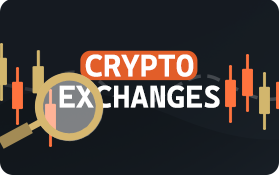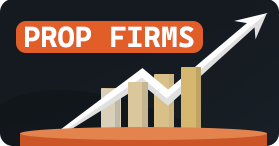How To Trade Cryptocurrency - The Beginners Guide
Learn about the finer details of cryptocurrency trading, including whether you should trade with a broker, exchange, or prop firm, plus whether crypto CFDs, futures, or real coins are right for you.
Learn about the finer details of cryptocurrency trading, including whether you should trade with a broker, exchange, or prop firm, plus whether crypto CFDs, futures, or real coins are right for you.
Our crypto platform comparisons and reviews are reader supported and we may receive payment when you click on a link to a partner site. For more information, read our About Us page.
Trading cryptocurrency really starts with understanding what you’re actually trading, how markets move, and which type of methods suits you. You may want to trade CFDs or futures with a broker, work through a challenge to get a funded account with a prop firm, or trade directly with an online exchange. While there’s big differences in pricing, regulation, and requirements across the various methods, the principles stay the same – recognize patterns, identify opportunities, manage risk, and execute your crypto trades with discipline.
 Cryptocurrency trading means buying and selling digital currency like Bitcoin, Ethereum, or Solana to take advantage of price movements. You can trade actual coins on a crypto exchange, known as spot trading, or use derivative products like CFDs and futures to speculate on the price movements of an underlying asset without actually owning it. Either way, your goal is to identify where a cryptocurrency market might move next and act on it. You’ll watch volatility, liquidity, and overall sentiment to predict price movements, then manage the significant risk that comes with digital assets through position sizing or stop losses so one trade doesn’t throw off your account.
Cryptocurrency trading means buying and selling digital currency like Bitcoin, Ethereum, or Solana to take advantage of price movements. You can trade actual coins on a crypto exchange, known as spot trading, or use derivative products like CFDs and futures to speculate on the price movements of an underlying asset without actually owning it. Either way, your goal is to identify where a cryptocurrency market might move next and act on it. You’ll watch volatility, liquidity, and overall sentiment to predict price movements, then manage the significant risk that comes with digital assets through position sizing or stop losses so one trade doesn’t throw off your account.
Cryptocurrency markets work through decentralized blockchain technology that record every transaction transparently across thousands of computers. Instead of relying on a central exchange like a stock market, most crypto assets trade on platforms that connect buyers and sellers through order books or automated market makers (AMMs). Prices change continuously as supply and demand adjust, with each trade updating the blockchain ledger.
Unlike traditional currencies and markets, cryptocurrency trading operates 24/7 across global exchanges, meaning liquidity, volatility, and price discovery are constant. The underlying blockchain ensures that ownership transfers are verified and irreversible, while smart contracts and network validators maintain trust without intermediaries. Because crypto markets never close, events in one region or network can ripple worldwide within minutes, driving the notoriously volatile environment that defines cryptocurrency trading.
Crypto trading differs from forex and stock markets in four key ways – market hours and access, regulation and transparency, volatility and liquidity, and how each asset class is valued.
Market Hours and Access
 Cryptocurrency exchanges and markets never close because digital asset transactions occur on blockchain networks rather than centralized exchanges, so you can trade any time including weekends. Forex runs five days a week, and stocks are limited to specific hours, so the constant access with crypto assets gives you more freedom but also less time to step back and reset.
Cryptocurrency exchanges and markets never close because digital asset transactions occur on blockchain networks rather than centralized exchanges, so you can trade any time including weekends. Forex runs five days a week, and stocks are limited to specific hours, so the constant access with crypto assets gives you more freedom but also less time to step back and reset.
Regulation and Transparency
 Stocks and forex operate under well-established financial regulation, but crypto trading is still a patchwork of rules that vary by country. Some regions have strong oversight, while others have almost none at all. Certain exchanges are regulated and follow clear compliance standards, while others operate with little supervision. Because of that, it’s important to research where your platform is licensed and how it protects your funds. Unlike stock or forex brokers in places like Europe, the UK, the USA, or Australia, most crypto exchanges don’t offer the same level of retail trader protection.
Stocks and forex operate under well-established financial regulation, but crypto trading is still a patchwork of rules that vary by country. Some regions have strong oversight, while others have almost none at all. Certain exchanges are regulated and follow clear compliance standards, while others operate with little supervision. Because of that, it’s important to research where your platform is licensed and how it protects your funds. Unlike stock or forex brokers in places like Europe, the UK, the USA, or Australia, most crypto exchanges don’t offer the same level of retail trader protection.
Volatility and Liquidity
 Crypto market volatility is much higher than other assets, and market prices can move significantly even without major news. But, the high volatility creates more opportunity, and of course also increases risk. Major coins like Bitcoin and Ethereum have deep liquidity similar to major forex pairs, while smaller altcoins can be thinly traded and prone to slippage.
Crypto market volatility is much higher than other assets, and market prices can move significantly even without major news. But, the high volatility creates more opportunity, and of course also increases risk. Major coins like Bitcoin and Ethereum have deep liquidity similar to major forex pairs, while smaller altcoins can be thinly traded and prone to slippage.
Asset Type and Valuation
 While forex is built around national currencies and stocks give you a share in a company’s performance, crypto is different. Crypto assets that don’t have earnings reports or physical backing behind them so their value comes from how much people believe in the technology, how widely it’s adopted, and the overall market sentiment at the time.
While forex is built around national currencies and stocks give you a share in a company’s performance, crypto is different. Crypto assets that don’t have earnings reports or physical backing behind them so their value comes from how much people believe in the technology, how widely it’s adopted, and the overall market sentiment at the time.
When you trade crypto, you’re operating in a younger, faster market that rewards precision and strong risk management, while the technical analysis tools are similar to forex and stock trading, the psychology and timing often feel completely different.
When you trade cryptocurrency, the first big decision is whether you want to own the coins or speculate on their price trends. You can buy digital assets through spot trading where you actually own the underlying cryptocurrency, or use CFDs with leverage, or futures markets where you bet on price trends. Each method has a different level of complexity, cost, and risk, so the best choice depends on your goals and experience.
Spot trading is the most straightforward way to trade crypto. You’re buying and selling actual coins on exchanges like Binance, Coinbase, or Kraken. Once you buy, the coins are yours. You can keep them in your exchange account or move them to a private crypto wallet if you want full control.
You’re exchanging one asset for another, such as Bitcoin Cash for US Dollars (BCH/USD) or Ethereum for Tether (ETH/USDT), and you only profit when you sell for more than you paid. Spot trading suits you if you prefer simplicity, direct ownership, and no leverage.
CFD trading lets you trade crypto prices without holding the coins themselves. You’re speculating on whether the price will rise or fall by trading a contract that tracks the real market. This approach is common with brokers like Eightcap or BlackBull Markets that operate on platforms such as MT4, MT5, or TradingView.
CFDs give you flexibility to go long or short, and you can use leverage to control a larger position with a smaller balance. It’s efficient and fast, especially if you prefer trading short-term moves, but leverage cuts both ways. A small price change can work in your favor or against you just as quickly, so risk management is essential.
Trading futures let you speculate where you think a cryptocurrency’s price will be in the future. They’re standardized contracts, often traded on cryptocurrency exchanges like Bybit or Binance Futures.
Some futures expire on a set date, while perpetual futures stay open and use funding rates to keep prices aligned with the spot market. Trading futures give you more control over leverage and strategy, but they also require more discipline because if the market moves too far against your position, your account can be liquidated automatically.
Futures trading appeals to more experienced traders who hedge long-term holdings, speculate on short-term volatility, or run structured strategies. Before you trade futures, make sure you understand how margin, funding rates, and liquidation thresholds work, because these details directly affect your balance.
For most active day traders, crypto futures are best because you get deep liquidity, low taker fees, easy long or short, and adjustable leverage. CFDs are great if you prefer regulated platforms, cash settled, and direct shorting without wallets, though leverage and hours depend on your region. Spot trading is simplest and fine for beginner traders, but without leverage or built-in shorting it’s less efficient for intraday setups.
Learning how to trade cryptocurrency requires an understanding of platforms and markets, how to trade, and risk management involving position sizing, margin, and leverage. Whether you trade with a crypto broker, exchange, or prop firm, these requirements are all the same, you must plan your trade, control your exposure, and execute with discipline. The key differences between the methods really comes down to how much control you have over the assets, how trades are settled, and how your account is structured.

Choosing How to Trade – Broker, Exchange, or Prop Firm?
Where you choose to trade cryptocurrency shapes how you approach the market. A broker lets you speculate on price without owning coins, an exchange gives you full asset control, and a prop firm provides company-funded capital if you can trade within set limits. Each method suits a different style and risk profile, and we use examples from our reviewed providers to help you see how they compare in practice.
 CFD brokers suit traders who want flexibility, low fees, fast execution, and the ability to go long or short without needing a crypto wallet. Top crypto brokers like Eightcap, BlackBull Markets, and Pepperstone all fall into this group.
CFD brokers suit traders who want flexibility, low fees, fast execution, and the ability to go long or short without needing a crypto wallet. Top crypto brokers like Eightcap, BlackBull Markets, and Pepperstone all fall into this group.
Eightcap is known as the best crypto broker because it has the largest range of CFDs on top of MT4, MT5, and TradingView, while BlackBull focuses on ECN execution and ideal for technical traders, and Pepperstone is the go to for anyone wanting to gain exposure in traditional markets and cryptocurrency. With any CFD broker, you’re trading market trends and price movements rather than the coins themselves, and trades are settled in cash rather than crypto.
 If you want to actually own the digital assets and hold them in a wallet, you’ll use a crypto exchange. The most popular virtual currency exchanges like Binance, Bybit, Coinbase, and Robinhood give you direct access to spot markets where you buy and sell real coins. Binance and Bybit are better suited to active traders who trade futures markets and margin products, while Coinbase and Robinhood keep things simple and more beginner friendly.
If you want to actually own the digital assets and hold them in a wallet, you’ll use a crypto exchange. The most popular virtual currency exchanges like Binance, Bybit, Coinbase, and Robinhood give you direct access to spot markets where you buy and sell real coins. Binance and Bybit are better suited to active traders who trade futures markets and margin products, while Coinbase and Robinhood keep things simple and more beginner friendly.
Cryptocurrency exchanges are ideal if you prefer holding coins, moving assets to private wallets, or combining trading with long term investing, though you’ll handle your own storage and transfers.
 Prop trading firms give you access to company capital once you pass an evaluation process, aka prop challenge. You trade under set drawdown and daily loss limits and if successful and secure a funded account, you get a profit share of anything you generate.
Prop trading firms give you access to company capital once you pass an evaluation process, aka prop challenge. You trade under set drawdown and daily loss limits and if successful and secure a funded account, you get a profit share of anything you generate.
Top prop firms such as Blueberry Funded and BrightFunded both include crypto CFD trading, and it suits anyone who is confident in their trading experience, but want to scale up without risking personal capital.
Once you’ve chosen where to trade, the next step is understanding how to actually buy or sell crypto. Every trade starts with a view on where you think the market is going and how much you’re willing to risk if you’re wrong.
If you’re trading on an exchange like Binance or Coinbase, you’ll see your trades fill directly in your wallet balance. With brokers like Eightcap or BlackBull Markets, trades settle in cash on your account, not as real coins. On a prop firm account, you’ll trade live markets using company funds, but the same order types apply, plan, execute, and manage your exits the same way.
Once your trade is open, controlling risk becomes your main job. Crypto’s volatility means prices can swing several percent in seconds, so you need clear limits before the market tests you.
You only need a wallet if you’re trading real coins, and if you trade through a CFD broker or a prop firm, your trades are settled in fiat or stablecoins, so there’s no blockchain transaction or wallet required. This setup avoids transfer delays and gas fees, which is why CFD trading is often more efficient for active traders.
But, if you’re buying coins directly on an exchange, you’ll need a wallet to store them securely. Exchanges provide built-in custodial wallets, but for long term holdings it’s safer to use a private wallet.
Wallets come in two main types:
In short, use an exchange wallet for convenience, a cold wallet for security, and you can skip wallets entirely if you trade through a broker or prop firm. What matters most is matching your storage method to your trading style – active traders need speed, investors need safety.
There are many ways to trade cryptocurrency, and no single strategy fits everyone. The right approach depends on your time, risk tolerance, and how actively you want to trade.

The most common methods include day trading and scalping, where you target short-term moves on liquid pairs; swing trading and long-term positioning, where you hold trades for days or weeks; and automated or copy trading, which uses systems or shared strategies to remove emotion from execution.
No matter which approach you use, risk management is the part that decides whether you stay consistent. The trading strategies below cover some of the most practical starting points, though there are many others, from range trading and mean reversion to algorithmic hedging, that you’ll discover as your experience grows.
Day trading and scalping work best on pairs with tight spreads and deep books, like BTC/USD and ETH/USD. You’re looking for clean intraday moves, quick execution, and predictable fills. Keep it simple: define a session, pick one or two setups you recognise, and cap your risk per trade.
Use limit orders where possible, place your stop first, and avoid overtrading after a win or a loss. If you trade CFDs on MT5 or TradingView, set alerts for key levels so you’re reacting to price, not chasing it. On exchanges, watch the order book and funding to avoid paying for noise.
Swing trading suits you if you prefer fewer, higher quality trades. You’re holding for days or weeks, so structure entries around clear levels, trend pullbacks, and daily closes, not five minute candles. Plan the trade on higher timeframes, then refine the entry on a lower one.
For long term positions, scale in with small increments and decide in advance what invalidates the idea. If you hold real coins, think about storage and whether you want to keep part of the position off exchange. If you hold CFDs or futures, account for overnight swaps or funding in your targets.
Many traders use automation to help execute strategies consistently with less manual labour, using hard code or use no code tools to run entries, exits, and position sizing the same way every time.
Copy trading can also shorten the learning curve, but treat it like outsourcing execution, not outsourcing risk. Check a strategy’s drawdowns, average hold time, and how it handles volatile sessions.
Whether you automate on MT5, cTrader, or TradingView, set hard daily loss limits and keep manual override ready if market conditions change.
Risk management is your edge when volatility spikes, and before you start trading decide your max risk per trade (usually 1-2% of your balance), and size positions from the stop distance, not from how confident you feel. Place stops where the trade idea is wrong, not where the loss feels comfortable, and avoid adding to losers and avoid doubling leverage to win back a hit.
Use a daily stop, track your metrics weekly, and reduce size after drawdowns until you’re back in rhythm. If you trade futures, watch margin and funding; if you trade spot, don’t let position size creep up just because there’s no leverage showing on screen. Consistency in risk makes the strategy you choose actually matter.
The best way for beginners to trade crypto is by using a demo account with a CFD broker. Demo accounts let you practice trading strategies in real market conditions without risking real money, which is ideal for learning how platforms, price movements, and leverage work. The top crypto brokers like Eightcap, BlackBull Markets, and Pepperstone all offer free demo accounts on MT4, MT5, and TradingView. Once you’re comfortable managing trades, technical analysis, and using stops, you can move to a small live account to trade for real.
Yes, $100 is enough to start trading cryptocurrency, though how far that initial investment gets you depends on whether you trade through a broker, exchange, or prop firm. With CFD brokers like BlackBull Markets, Pepperstone, or IG, you can open a live account with no minimum deposit, and crypto exchanges Binance accepts as little as $5, KuCoin just $1, and Coinbase $2, but obviously more is needed to manage a wallet and cover trading fees. For prop firms, $100 is enough to buy challenges with smaller account sizes like 5K to 25K. Blueberry Funded has challenges starting from $35, while BrightFunded begins at €55.
Anyone trading cryptocurrency needs to be comfortable with short term volatility but not reckless with risk or investment choices. Market prices can swing fast, so you must use stop losses, small position sizes, and clear rules for exits. Having a high risk tolerance doesn’t mean taking big losses or making poor investment decisions, it means being able to handle fluctuations without emotional decisions. If you have a strong track record of disciplined trading, you’ll perform better long term than those chasing large, high risk trading opportunities.
Copyright 2025 Prop Firms. All rights reserved. This site is independent and not affiliated with The Rock Trading S.R.L. or its liquidators. The original exchange has ceased operations and this website is for informational purposes only.